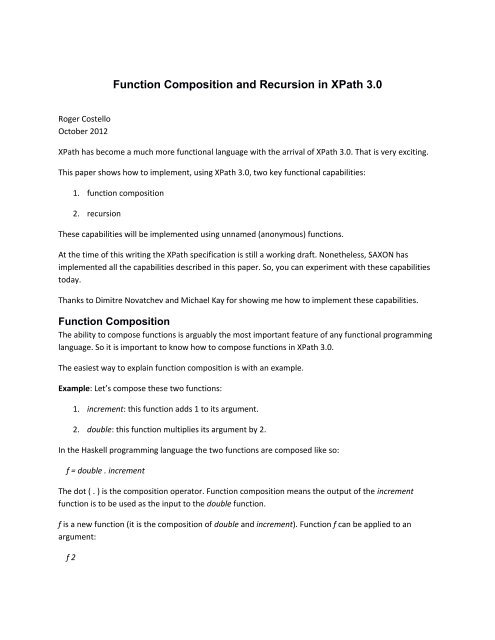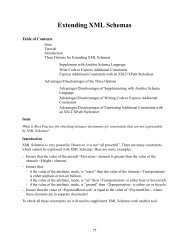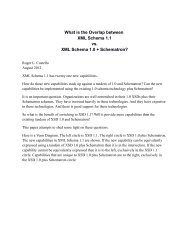Function Composition and Recursion in XPath 3.0 - xFront
Function Composition and Recursion in XPath 3.0 - xFront
Function Composition and Recursion in XPath 3.0 - xFront
Create successful ePaper yourself
Turn your PDF publications into a flip-book with our unique Google optimized e-Paper software.
<strong>Function</strong> <strong>Composition</strong> <strong>and</strong> <strong>Recursion</strong> <strong>in</strong> <strong>XPath</strong> <strong>3.0</strong><br />
Roger Costello<br />
October 2012<br />
<strong>XPath</strong> has become a much more functional language with the arrival of <strong>XPath</strong> <strong>3.0</strong>. That is very excit<strong>in</strong>g.<br />
This paper shows how to implement, us<strong>in</strong>g <strong>XPath</strong> <strong>3.0</strong>, two key functional capabilities:<br />
1. function composition<br />
2. recursion<br />
These capabilities will be implemented us<strong>in</strong>g unnamed (anonymous) functions.<br />
At the time of this writ<strong>in</strong>g the <strong>XPath</strong> specification is still a work<strong>in</strong>g draft. Nonetheless, SAXON has<br />
implemented all the capabilities described <strong>in</strong> this paper. So, you can experiment with these capabilities<br />
today.<br />
Thanks to Dimitre Novatchev <strong>and</strong> Michael Kay for show<strong>in</strong>g me how to implement these capabilities.<br />
<strong>Function</strong> <strong>Composition</strong><br />
The ability to compose functions is arguably the most important feature of any functional programm<strong>in</strong>g<br />
language. So it is important to know how to compose functions <strong>in</strong> <strong>XPath</strong> <strong>3.0</strong>.<br />
The easiest way to expla<strong>in</strong> function composition is with an example.<br />
Example: Let’s compose these two functions:<br />
1. <strong>in</strong>crement: this function adds 1 to its argument.<br />
2. double: this function multiplies its argument by 2.<br />
In the Haskell programm<strong>in</strong>g language the two functions are composed like so:<br />
f = double . <strong>in</strong>crement<br />
The dot ( . ) is the composition operator. <strong>Function</strong> composition means the output of the <strong>in</strong>crement<br />
function is to be used as the <strong>in</strong>put to the double function.<br />
f is a new function (it is the composition of double <strong>and</strong> <strong>in</strong>crement). <strong>Function</strong> f can be applied to an<br />
argument:<br />
f 2
The result is 6. That is the expected result:<br />
- add 1 to the argument: (2 + 1)<br />
- then multiply by 2: (2 + 1) * 2<br />
- to produce the result: (2 + 1) * 2 = 6<br />
<strong>XPath</strong> <strong>3.0</strong> Implementation<br />
<strong>Function</strong> <strong>in</strong>crement is implemented <strong>in</strong> <strong>XPath</strong> <strong>3.0</strong> like so:<br />
$<strong>in</strong>crement := function($x as xs:<strong>in</strong>teger) {$x + 1}<br />
Read as: the variable <strong>in</strong>crement is assigned a value that is an (unnamed) function which takes as its<br />
argument an (XML Schema, xs) <strong>in</strong>teger x. The function returns the value of x plus 1.<br />
<strong>Function</strong> double is implemented:<br />
$double := function($y as xs:<strong>in</strong>teger) {$y * 2}<br />
Read as: the variable double is assigned a value that is an (unnamed) function which takes as its<br />
argument an (XML Schema, xs) <strong>in</strong>teger y. The function returns the value of y multiplied by 2.<br />
Next, we create an (unnamed) function that composes two functions, a <strong>and</strong> b. It returns an (unnamed)<br />
function. The returned function takes one argument, c, <strong>and</strong> returns the result of apply<strong>in</strong>g a to c <strong>and</strong><br />
then b to a(c):<br />
$compose := function(<br />
$a as function(item()*) as item()*,<br />
$b as function(item()*) as item()*<br />
)<br />
as function(item()*) as item()*<br />
{function($c as item()*) as item()* {$b($a($c))}}<br />
Read as: the variable compose is assigned a value that is an (unnamed) function which takes two<br />
arguments, a <strong>and</strong> b. Both a <strong>and</strong> b are functions. The unnamed function returns an unnamed function.<br />
The returned function takes one argument, c. The implementation of the returned function is to apply a<br />
to c <strong>and</strong> then apply b to the result.<br />
This is a great example of a higher-order function. A higher-order<br />
function is a function that takes as its arguments function(s) <strong>and</strong>/or<br />
returns as its result a function. In this example, the function takes two<br />
functions as arguments <strong>and</strong> returns a function. Wow!<br />
Next, we assign to variable f the result of compos<strong>in</strong>g function <strong>in</strong>crement <strong>and</strong> double:
$f := $compose($<strong>in</strong>crement, $double)<br />
Lastly, apply f to some value, say 2:<br />
$f(2)<br />
Here is the complete <strong>XPath</strong> <strong>3.0</strong> program:<br />
let $<strong>in</strong>crement := function($x as xs:<strong>in</strong>teger) {$x + 1},<br />
$double := function($y as xs:<strong>in</strong>teger) {$y * 2},<br />
$compose := function(<br />
$a as function(item()*) as item()*,<br />
$b as function(item()*) as item()*<br />
)<br />
as function(item()*) as item()*<br />
{function($c as item()*) as item()* {$b($a($c))}},<br />
$f := $compose($<strong>in</strong>crement, $double)<br />
return $f(2)<br />
Observe these th<strong>in</strong>gs:<br />
- Each statement is separated from the next by a comma<br />
- The first statement is <strong>in</strong>itiated with the keyword, let<br />
- The format is: let statement, statement, …, statement return expression<br />
That <strong>XPath</strong> program can be used <strong>in</strong> an XSLT <strong>3.0</strong> program, an XQuery <strong>3.0</strong> program, <strong>and</strong> any language that<br />
supports <strong>XPath</strong> <strong>3.0</strong>.<br />
That is a beautiful program.<br />
<strong>Recursion</strong><br />
<strong>XPath</strong> <strong>3.0</strong> does not support named functions. It only provides unnamed (anonymous) functions. So<br />
recursion is a bit tricky – how do you recurse <strong>in</strong> a function that has no name? This section shows how.<br />
The technique shown <strong>in</strong> this paper was discovered by Dimitre Novatchev.<br />
The easiest way to expla<strong>in</strong> the technique is with an example.<br />
Example: Let’s implement a recursive until function (loop until some condition is satisfied).<br />
<strong>Function</strong> until takes three arguments:<br />
1. p is a boolean function<br />
2. f is a function on x
3. x is the value be<strong>in</strong>g processed<br />
Here is an example us<strong>in</strong>g the function:<br />
$until ($isNegative, $decrement, 3)<br />
Read as: decrement 3 until it is negative. The result is (-1).<br />
<strong>XPath</strong> <strong>3.0</strong> Implementation<br />
<strong>Function</strong> isNegative is implemented <strong>in</strong> <strong>XPath</strong> <strong>3.0</strong> like so:<br />
$isNegative := function($x as xs:<strong>in</strong>teger) {$x lt 0}<br />
Read as: the variable isNegative is assigned a value that is an (unnamed) function which takes as its<br />
argument an (XML Schema, xs) <strong>in</strong>teger x. The function returns True if x is less than 0 <strong>and</strong> False<br />
otherwise.<br />
<strong>Function</strong> decrement is implemented:<br />
$decrement := function($x as xs:<strong>in</strong>teger) {$x - 1}<br />
Read as: the variable decrement is assigned a value that is an (unnamed) function which takes as its<br />
argument an (XML Schema, xs) <strong>in</strong>teger x. The function returns the value of x m<strong>in</strong>us 1.<br />
Now it is time to implement function until. Here it is:<br />
$until := function(<br />
$p as function(item()*) as xs:boolean,<br />
$f as function(item()*) as item()*,<br />
$x as item()*<br />
) as item()*<br />
{$helper($p, $f, $x, $helper)}<br />
Read as: the variable until is assigned a value that is an (unnamed) function which takes 3 arguments: a<br />
function, p, that takes an argument <strong>and</strong> returns a boolean value, a function, f, that takes an argument<br />
<strong>and</strong> returns a result, <strong>and</strong> a value, x. The function <strong>in</strong>vokes another function that I called helper. <strong>Function</strong><br />
helper is <strong>in</strong>voked with p, f, x, <strong>and</strong> itself.<br />
This is key: to implement recursion with unnamed functions you must assign the unnamed function to a<br />
variable <strong>and</strong> <strong>in</strong>voke the function by pass<strong>in</strong>g it the variable. Wow!
Okay, let’s look at the helper function:<br />
$helper := function(<br />
$p as function(item()*) as xs:boolean,<br />
$f as function(item()*) as item()*,<br />
$x as item()*,<br />
$helper as function(function(), function(), item()*, function()) as item()*<br />
) as item()*<br />
{if ($p($x)) then $x else $helper($p, $f, $f($x), $helper)}<br />
Read as: the variable helper is assigned a value that is an (unnamed) function which takes 4 arguments:<br />
p, f, x, <strong>and</strong> helper. The function applies p to x <strong>and</strong> if the result is True then it returns x, otherwise it<br />
recurses, call<strong>in</strong>g helper with p, f, f(x), <strong>and</strong> helper.<br />
Lastly, let’s apply until to some value, say 3:<br />
$until($isNegative, $decrement, 3)<br />
The result is the value (-1).<br />
Here is the complete <strong>XPath</strong> <strong>3.0</strong> program:<br />
let $isNegative := function($x as xs:<strong>in</strong>teger) {$x lt 0},<br />
$decrement := function($x as xs:<strong>in</strong>teger) {$x - 1},<br />
$helper := function(<br />
$p as function(item()*) as xs:boolean,<br />
$f as function(item()*) as item()*,<br />
$x as item()*,<br />
$helper as function(function(), function(), item()*, function()) as item()*<br />
) as item()*<br />
{if ($p($x)) then $x else $helper($p, $f, $f($x), $helper)},<br />
$until := function(<br />
$p as function(item()*) as xs:boolean,<br />
$f as function(item()*) as item()*,<br />
$x as item()*<br />
) as item()*<br />
{$helper($p, $f, $x, $helper)}<br />
return $until($isNegative, $decrement, 3)<br />
This is a fantastic technique.






